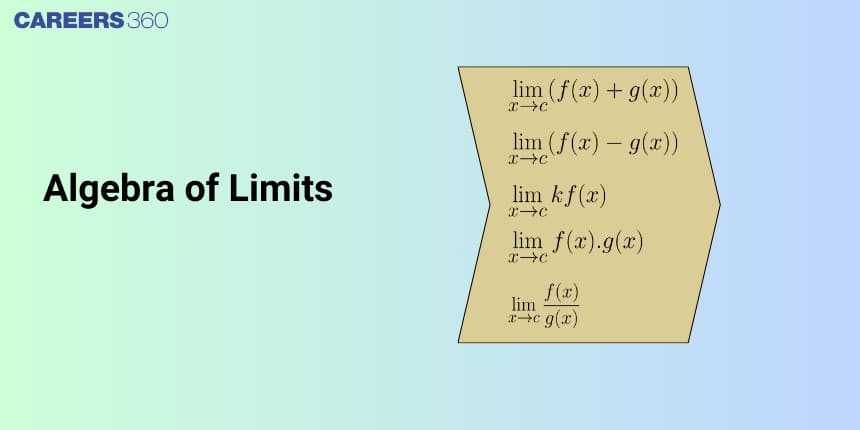Algebra of Limits
The algebra of limits is one of the core topics in learning how to manipulate and combine functions at their limits. An understanding of calculus begins with the mastery of the algebra of limits. This is elementary knowledge to consider changes, optimize processes, and forecast trends in engineering, physics, and economics. It is from this algebra of limits that we can explore the behavior of a function in the vicinity of some particular point, even though, at one specific point, the function remains undefined. This simple idea enables us to solve the most complicated problems related to the real world and equations in mathematics, which include finding derivatives and integrals.
JEE Main: Study Materials | High Scoring Topics | Preparation Guide
JEE Main: Syllabus | Sample Papers | Mock Tests | PYQs
- Limit of a function
- What is Algebra of Limits?
- Solved Examples Based On Algebra Of Limits:

In this article, we will cover the concept of the Algebra of Limits. This topic falls under the broader category of Calculus, which is a crucial chapter in Class 11 Mathematics. This is very important not only for board exams but also for competitive exams, which even include the Joint Entrance Examination Main and other entrance exams: SRM Joint Engineering Entrance, BITSAT, WBJEE, and BCECE. A total of ten questions have been asked on this topic in JEE Main from 2013 to 2023, two questions in 2018 and three in 2019, one in 2021, and four in 2024.
Limit of a function
If
What is Algebra of Limits?
Algebra of limits operates under several rules or properties, making it possible to determine the limits of functions from their algebraic combinations. These rules make finding limits easier and are some of the most important tools within calculus. The basic algebraic operations include addition, subtraction, multiplication, and division of limits.
Let
Sum law for limits :
Difference law for limits :
Constant multiple law for limits :
Product law for limits :
Quotient law for limits :
Power law for limits :
Composition law of limit:
If
Recommended Video Based on Algebra of Limits
Solved Examples Based On Algebra Of Limits:
Example 1:
1)
2)
3)
4)
Solution:
Evaluation of Trigonometric limit -
put
Then it comes
Limit of product/quotient -
Limit of product/quotient is the product/quotient of individual limits such that
Also
Using LH Rule
Hence, the answer is the option 2.
Example 2:
1)
2)
3)
4)
Solution:
As we have learned
Limit of product/quotient -
Limit of product is the product of individual limits such that
Hence, the answer is the option 3.
Hence, the answer is the option 3.
Example 3: For each
1) equals
2) equals
3) equals
4) does not exist
Solution:
Limit of productiquotient is the product/quotient of individual limits such that
Evaluation of Trigonometric limit -
put
Then it comes
Example 4: Let
1)
2)
3)
4)
Solution:
Hence, the answer is the option 1.
Example 5: Let
[JEE Main 2023]
1)
2)
3)
4)
Solution:
RHL
Hence, the answer is the option 4.
Frequently Asked Questions (FAQs)
The concept of limits is the cornerstone on which the development of calculus rests. Limits help in understanding the behavior of functions as they approach specific points, which is essential for studying continuity, derivatives, and integrals.
No, the limit does not exist for zero because for saying that limit exists; the function has to approach the same value regardless of which direction
A function
The basic algebraic operations include addition, subtraction, multiplication, and division of limits.
Also Read
22 Mar'25 01:25 AM
22 Mar'25 01:19 AM
14 Feb'25 07:09 PM
14 Feb'25 06:59 PM
14 Feb'25 06:54 PM
14 Feb'25 06:51 PM
14 Feb'25 06:49 PM
02 Feb'25 09:04 PM
02 Feb'25 09:00 PM
02 Feb'25 08:54 PM

